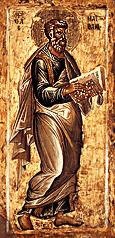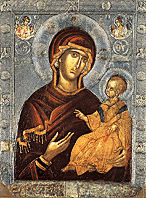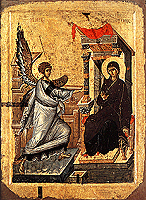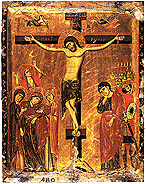 |
|
 |
Icons
 any and of superlative quality are the examples of icons painted in the
Palaiologan period. Stylistically, the icons follow the developments of
monumental painting, while the themes depicted increase.
any and of superlative quality are the examples of icons painted in the
Palaiologan period. Stylistically, the icons follow the developments of
monumental painting, while the themes depicted increase.
 The florescence of the art of icon painting from the middle of the 13th century on has been connected to the recovery of Constantinople (1261), which was now once again the main artistic centre of the Empire. Also, the general atmosphere of the period has been considered as favourable to the
The florescence of the art of icon painting from the middle of the 13th century on has been connected to the recovery of Constantinople (1261), which was now once again the main artistic centre of the Empire. Also, the general atmosphere of the period has been considered as favourable to the
 increase in the number of icons. The difficult political conditions, the gradual weakening of the centralised structures of the state and the greater independence in family and personal life, resulted in a wider spread of private worship. The consequence of increase in the number of icons. The difficult political conditions, the gradual weakening of the centralised structures of the state and the greater independence in family and personal life, resulted in a wider spread of private worship. The consequence of
 all this was an increased demand for what was seen as the main medium of personal communication with the Divine, the icon. all this was an increased demand for what was seen as the main medium of personal communication with the Divine, the icon.
Outstanding among the many fine examples of 13th-century icon painting is the icon of St James from Patmos, which is stylistically related to the frescoes of Sopocani and is representative of the art of the Capital after the middle of the 13th century. Correspondingly, the monumental figure of the evangelist St. Matthew, in an icon from Ohrid, is reminiscent of works of the end of the 13th century, such as the frescoes of St Kliment (former Virgin Peribleptos) in the same town. Two
double-sided icons
 of Christ and the Virgin Psychosostria (the Redeemer of Souls) bearing the Crucifixion and the Annunciation respectively on their reverse sides and displayed in the
museum of Ohrid, are the best examples of the metropolitan art of the time. It is believed that they were gifts offered by the Emperor
Andronikos II
to the archbishop of Ohrid, Gregory. of Christ and the Virgin Psychosostria (the Redeemer of Souls) bearing the Crucifixion and the Annunciation respectively on their reverse sides and displayed in the
museum of Ohrid, are the best examples of the metropolitan art of the time. It is believed that they were gifts offered by the Emperor
Andronikos II
to the archbishop of Ohrid, Gregory.
Finally, mention should be made of a group of icons now in the monastery of St Catherine's in Sinai. These icons all present a series of stylistic and iconographic features that reveal a knowledge of both purely Byzantine art and the Western modes of expression. These icons have been regarded as creations of the Latin-occupied Christian East and are known as "Crusader" icons.
|